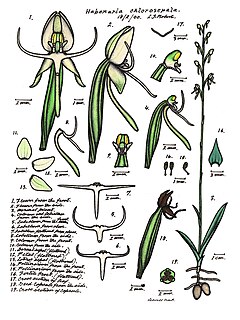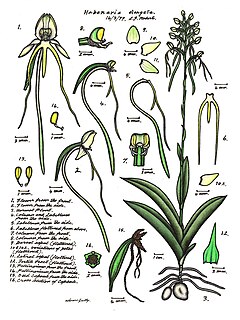Zeuxine exilis, commonly known as Ridley's jewel orchid or the slender jewel orchid, is a species of orchid that is endemic to Christmas Island where it grows in rainforest. It has three or four egg-shaped leaves and up to thirty small, dull reddish flowers crowded along a thin, hairy flowering stem. It was first recorded in 1904 but was not seen again until 2009.
Arthrochilus prolixus, commonly known as wispy elbow orchid, is a flowering plant in the orchid family (Orchidaceae) and is endemic to eastern Australia. It has a rosette of bluish green leaves at its base and up to twenty two pale green, insect-like flowers with dark reddish to purplish glands on its labellum.

Habenaria chlorosepala, commonly known as the green-hooded rein orchid, is a species of orchid that is endemic to a small area in far north Queensland. It has two or three leaves at its base and up to twenty small green and white flowers.

Habenaria elongata, commonly known as the white rein orchid, or Kimberley spider orchid, is a species of orchid that is endemic to northern Australia. It has up to four leaves at its base and up to twenty small white flowers with yellowish tips and thread-like lobes on the labellum.
Habenaria euryloba, commonly known as the small rein orchid, is a species of orchid that is endemic to a small area in far north Queensland. It has two or three leaves at its base and up to twenty small white flowers with a trident-like labellum.
Habenaria ferdinandi, commonly known as the yellow rein orchid, is a species of orchid that is endemic to the Northern Territory. It usually has two leaves at its base and up to fifteen tiny yellowish green, strongly scented flowers.
Habenaria fuscina, commonly known as the green rein orchid, is a species of orchid that is endemic to Cape York Peninsula. It has two or three leaves at its base and up to fifteen small green and white flowers with a labellum shaped like a trident.
Habenaria halata, commonly known as the sweet rein orchid, is a species of orchid that is endemic to northern parts of the Northern Territory. It has two or three leaves at its base and up to eighteen small white, sweet-smelling flowers with a labellum shaped like a trident.
Peristylus banfieldii, commonly known as the yellow ogre orchid, is a species of orchid that is endemic to Tropical North Queensland. It has between four and six leaves near its base and up to fifty cup-shaped, cream-coloured to yellow flowers on a hairy flowering stem.
Habenaria harroldii, commonly known as the southern rein orchid, is a species of orchid that is endemic to the Fraser Coast region of Queensland. It has up to five leaves at its base and up to twenty five white flowers with reduced side lobes on the labellum.
Habenaria hymenophylla, commonly known as the coastal rein orchid, is a species of orchid that is endemic to northern Australia. It up to eight leaves scattered along the stem and up to thirty smelly green and white flowers.

Habenaria propinquior, commonly known as the common rein orchid, is a species of orchid that is endemic to north Queensland. It has two to four leaves at its base and up to thirty white flowers with thread-like lobes on the labellum.

Habenaria rumphii, commonly known as the stiff rein orchid, is a species of orchid that is widespread and common in Southeast Asia, New Guinea and northern Australia. It has six or seven leaves on the lower part of its stem and up to thirty white flowers with one long and two short lobes on the labellum.
Habenaria macraithii, commonly known as the whiskered rein orchid, is a species of orchid that is endemic to a small area in far north Queensland. It has up to eleven scattered leaves and up to twenty five relatively large green flowers with thread-like petal lobes.
Habenaria ochroleuca, commonly known as the sickle orchid or sickle habenaria, is a species of orchid that is endemic to northern Australia. It has two or three broad, glabrous leaves and up to twenty five white flowers on a flowering stem with many overlapping bracts. The side lobes of the labellum curve upwards.
Habenaria praecox, commonly known as the early rein orchid, is a species of orchid that is endemic to the north coast of Queensland. It has between two and four narrow, upright leaves at its base and up to thirty five small white flowers with a green dorsal sepal.
Habenaria triplonema, commonly known as the twisted rein orchid, is a species of orchid that is endemic to northern Australia. It two or three leaves at its base and up to twenty five yellowish, strongly scented flowers.

Peristylus maingayi, commonly known as the white ogre orchid, is a species of orchid that is native to southern Indochina, New Guinea and north Queensland. It has two or three broad leaves near its base and up to fifteen small white flowers that are tube-shaped near the base and have a three-lobed labellum.
Habenaria vatia, commonly known as the curved rein orchid, is a species of orchid, that is endemic Queensland where it is only known from a small number of islands. It has between three and five leaves at its base and up to twenty-five small white flowers with a relatively long green and white nectary spur.

Habenaria xanthantha, commonly known as the freak rein orchid, is a species of orchid that is endemic to far northern Queensland. It has two or three leaves at its base and up to twenty small white flowers often lacking the nectary spur present on other species in the genus.






